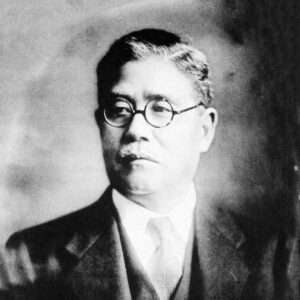
Businessman, born in 1882 (Meiji 15) to the Kobayashi family in Aoki Village near Bessho Hot Springs in Ogata County, Nagano Prefecture. He studied at Matsumoto Junior High School, Tokyo Higher Normal School (now Tokyo University of Education), and worked as an English teacher at the 4-day commercial school in Mie Prefecture, but decided to go on to Tokyo University. During this time, he tutored Masaaki Tomii and Takaaki Kato to finance his studies, and was greatly influenced by the hard-hearted personality of Takaaki Kato, who later became the prime minister of Japan. After graduating from the University of Tokyo with a degree in law at the end of the Meiji era (1868-1912), he worked for about ten years in the elite bureaucracy, first at the Ministry of Agriculture and Commerce and then at the Ministry of Railways, but in 1920, he gave up his life as an official and became an executive at Musashi Electric Railway Company.
Musashi Electric Railway was renamed Tokyo-Yokohama Electric Railway, and in 1932, the entire line between Shibuya, Tokyo and Sakuragicho, Yokohama was completed. During World War II, he merged Odakyu, Keihin, Keio, Sagami, Hakone Tozan Railway, and other large and medium-sized private railways to create the largest private railway company in Japan, Dai Tokyu. During this period, he ran the Toyoko Department Store, and after the war, he started the Toyoko Motion Picture Company (Toei), demonstrating his varied activities. While in the government service, he married the eldest daughter of Kume Taminosuke, a railroad manager in Korea, and started the Goto family, which had ceased to exist in his grandmother’s house, and changed his family name to Goto. His interest in art began with collecting rare old sutra manuscripts, and today, more than 30 Nara-period and 80 Heian-period manuscripts, as well as about 100 pieces from the Kamakura period onward, including the national treasure Rishu-kyo, are housed in the Goto Museum of Art, along with many other masterpieces such as “Murasaki Shikibu Diary Illustrated Texts”. Next, his interest in tea ceremony utensils expanded. His contact with the tea ceremony began when he was invited to a tea ceremony held by Kobayashi Ichizo (Itsuo) at his residence in Ikeda, Osaka, around 1930-1940, and he began to learn the tea ceremony himself. At that time, he was in charge of the Ensei-an and personally performed Kakegama at the Daishi-kai at Gokoku-ji Temple in Tokyo in 1953. In his later years, he collected many Japanese tea bowls, which are now in the collection of the Goto Museum of Art. He died in 1959 at the age of 77.



